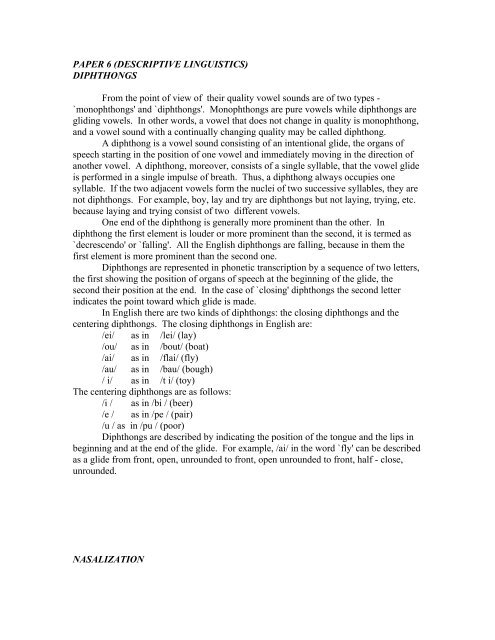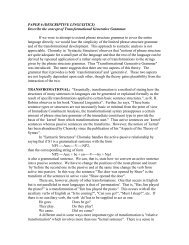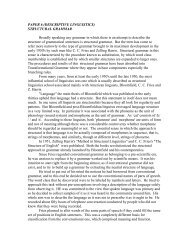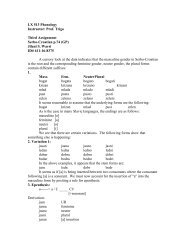PAPER 6 (DESCRIPTIVE LINGUISTICS ... - Jilani S. Warsi
PAPER 6 (DESCRIPTIVE LINGUISTICS ... - Jilani S. Warsi
PAPER 6 (DESCRIPTIVE LINGUISTICS ... - Jilani S. Warsi
Create successful ePaper yourself
Turn your PDF publications into a flip-book with our unique Google optimized e-Paper software.
<strong>PAPER</strong> 6 (<strong>DESCRIPTIVE</strong> <strong>LINGUISTICS</strong>)<br />
DIPHTHONGS<br />
From the point of view of their quality vowel sounds are of two types -<br />
`monophthongs' and `diphthongs'. Monophthongs are pure vowels while diphthongs are<br />
gliding vowels. In other words, a vowel that does not change in quality is monophthong,<br />
and a vowel sound with a continually changing quality may be called diphthong.<br />
A diphthong is a vowel sound consisting of an intentional glide, the organs of<br />
speech starting in the position of one vowel and immediately moving in the direction of<br />
another vowel. A diphthong, moreover, consists of a single syllable, that the vowel glide<br />
is performed in a single impulse of breath. Thus, a diphthong always occupies one<br />
syllable. If the two adjacent vowels form the nuclei of two successive syllables, they are<br />
not diphthongs. For example, boy, lay and try are diphthongs but not laying, trying, etc.<br />
because laying and trying consist of two different vowels.<br />
One end of the diphthong is generally more prominent than the other. In<br />
diphthong the first element is louder or more prominent than the second, it is termed as<br />
`decrescendo' or `falling'. All the English diphthongs are falling, because in them the<br />
first element is more prominent than the second one.<br />
Diphthongs are represented in phonetic transcription by a sequence of two letters,<br />
the first showing the position of organs of speech at the beginning of the glide, the<br />
second their position at the end. In the case of `closing' diphthongs the second letter<br />
indicates the point toward which glide is made.<br />
In English there are two kinds of diphthongs: the closing diphthongs and the<br />
centering diphthongs. The closing diphthongs in English are:<br />
/ei/ as in /lei/ (lay)<br />
/ou/ as in /bout/ (boat)<br />
/ai/ as in /flai/ (fly)<br />
/au/ as in /bau/ (bough)<br />
/ i/ as in /t i/ (toy)<br />
The centering diphthongs are as follows:<br />
/i / as in /bi / (beer)<br />
/e / as in /pe / (pair)<br />
/u / as in /pu / (poor)<br />
Diphthongs are described by indicating the position of the tongue and the lips in<br />
beginning and at the end of the glide. For example, /ai/ in the word `fly' can be described<br />
as a glide from front, open, unrounded to front, open unrounded to front, half - close,<br />
unrounded.<br />
NASALIZATION
A nasal consonant is produced by a complete oral closure, that is, the oral passage<br />
of air is completely blocked by the articulators coming into firm contact with each other<br />
but the soft palate is lowered so that the nasal passage of air is open. Thus air has a free<br />
passage through the nose.<br />
There are three nasal consonant phonemes in English. They are<br />
/m/ - bilabial<br />
/n/ - alveolar<br />
/n/ - velar<br />
1. During the articulation of /m/, two lips are brought together blocking the oral passage<br />
of air completely. The soft palate is lowered and the air escapes through the nose. The<br />
vocal cords vibrate, producing voice. Thus /m/ is a voiceless bilabial. Spelling: /m/ is<br />
represented by m, mm, mb and mn as in many, summer, comb and autumn respectively.<br />
/m/ can occur initially, medially and finally as in man, enemy and some.<br />
2. During the articulation of /n/ the tip of the tongue makes a firm contact with the upper<br />
teeth ridge, thus blocking off the oral passage of air completely. The soft palate is<br />
lowered so that the air escapes through the nose. The vocal cords vibrate producing<br />
voice. Thus /n/ is a voiced alveolar nasal. Spelling: /n/ is represented by the letter `n' as<br />
in near, neat; by the letters `nn' as in running; initial `kn' as in knight, knife and final `gn'<br />
as in sign, assign, etc. Thus /n/ occurs initially, medially and finally as in number, many<br />
and burn respectively.<br />
3. During the articulation of /n/ sound, the oral closure is made by the back of the tongue<br />
making a firm contact against the soft palate. The soft palate is lowered, thereby<br />
allowing the air to escape freely through the nose. Thus /n/ is a voiced, velar, nasal.<br />
Spelling: /n/ can be represented by `ng' as in sing, king; `kn' as in donkey, monkey, etc.<br />
/n/ occurs medially and finally as in `uncle' and `king'. It never occurs initially.<br />
SYLLABLE<br />
The units or sections into which words are divided while pronouncing them are<br />
called syllables. When we speak, the air from the lungs does not come out in a<br />
continuous stream at a constant pressure. The muscles of the chest push the air out in<br />
small puffs at the rate of appropriately five times a second, and each puff of air produces
a syllable and each movement of the chest is called a `chest pulse'. Occasionally a chest<br />
pulse is produced by greater muscular effort. This is called a `reinforced chest pulse'<br />
which produces a stressed syllable. For example, the English word `accident' has three<br />
syllables / k-si-dent/ and the first syllable is stressed while the rest of the two syllables<br />
are unstressed. And it is on the arrangement of stressed and unstressed syllables and the<br />
way they follow one another that the rhythm of a language depends.<br />
The syllable can be analyzed in terms of its elements or segments, also called<br />
speech sounds. These segments fall into two classes: vowels and consonants. In other<br />
words, a syllable is made up of one or more speech sounds. For example, the first<br />
syllable ta /tei/ of the word `table' has two speech sounds - a consonant /t/ and a vowel<br />
/ei/.<br />
As a syllable is produced by a chest pulse, there must be a free and unrestricted<br />
passage during, at least, a part of the production of the syllable. And it is during this part<br />
of the syllable that a vowel is produced. It carries the chest pulse and is the nucleus or<br />
the central part of the syllable. On the other hand, a consonant is marginal, that is, it<br />
occurs either at the beginning or at the end of a syllable, or both at the beginning and at<br />
the end. A consonant at the beginning of a syllable is called an `arresting consonant'.<br />
For example, the word `pick' consists of two marginal elements /p/, a releasing consonant<br />
and /k/, an arresting consonant and a nucleus /i/ which is a vowel.<br />
While describing the structure of syllables, we use the symbol C & V for a<br />
consonant and a vowel respectively. For example, the structure of the syllable /tei/ of the<br />
word `table' /teibl/ will be CV. It is also possible to have a cluster of two or more<br />
consonants before and/or after the nucleus as in the word `school' /sku:l/ i.e. CCVC.<br />
Some syllables are made up of nucleus alone as in `eye' or `I' /ai/. It has no consonant or<br />
vowel before it.<br />
A syllable which is arrested by a consonant is called a `closed syllable' and one<br />
which has no arresting consonants is called an `open syllable'.<br />
It is on the basis of the number of syllables that the words are classified into<br />
monosyllabic, disyllabic and polysyllabic, consisting of one, two and many syllables<br />
respectively. Sometimes two syllables in a word may be fused into one by suppressing a<br />
vowel sound in pronunciation, i.e. wa-t (e) ry, lit (e) ral. This process is known as<br />
`elision' or `slurring'.<br />
<strong>PAPER</strong> 6 (<strong>DESCRIPTIVE</strong> <strong>LINGUISTICS</strong><br />
SUPRASEGMENTAL PHONEMES<br />
The phenomena of segmentation of consonants and vowels may be important in<br />
the analysis of the sound system of a language. Stress and pitch differences, for example,<br />
might result in difference of meaning. In one dialect of Chinese [ma] with a high-level<br />
pitch means `mother', but [ma] with a low and mainly level pitch means `horse'. We must<br />
therefore say that in this dialect of Chinese, pitch is phonemic because we have a<br />
minimal pair, just as `bit' and `pit' are minimal pair in English. In English, pitch
differences function syntactically, that is, they function in relation to whole utterances,<br />
rather than in relation to the individual meaning -bearing parts of utterances.<br />
In English, the stress in words such as perfect, permit and pervert shifts according<br />
to how these words are used in context:<br />
a perfect day to perfect the idea<br />
a new permit to permit him to go<br />
a sex pervert to pervert justice<br />
Consequently we may argue that stress is phonemic in English and postulate<br />
several stress phonemes because the different syllables of certain expressions have<br />
different degrees of stress. For example, in a dusty briefcase, brief carries the most heavy<br />
stress / /, dust the second most heavy stress / /, (or alternatively, are unstressed), so the<br />
four degrees of stress distribute as follows:<br />
a dusty briefcase / / primary stress<br />
/ / secondary stress<br />
/ / tertiary stress<br />
/ / unstressed<br />
Furthermore, many minimal pairs can be found to justify these contrasts.<br />
a hot rod a car<br />
a hot rod a hot piece of metal<br />
OR<br />
a hot rod a hot piece of metal<br />
a briefcase a container for papers<br />
a brief case a case that was brief<br />
OR<br />
a brief case a brief case (not a brief something else)<br />
English patterns have sometimes been related to pauses between words. For example, we<br />
can say that such words as `nitrate', `night rate', and `Nay trait' require the postulation of<br />
a juncture phoneme to show the difference.<br />
Nitrate<br />
Night /+/ rate /+/ juncture<br />
Nay /+/ trait<br />
This juncture phoneme apparently indicates a significant pause. Its allophones are<br />
difficult to define, however, since it is a significant `nothing', it has been claimed that in<br />
the presence of /+/ other phonemes have final allophones preceding /+/ and initial<br />
allophones following /+/.<br />
In the same way we can say that utterances such as:<br />
He left.<br />
He left?<br />
"He left", I said.<br />
must be differently represented phonemically because of the way the pitch of the voice<br />
falls on left in the first case, rises on left in the second, and stays level on left in the third.<br />
Three phonemes have been postulated to account for the differences:<br />
/#/ falling terminal contour<br />
/"/ rising terminal contour<br />
/'/ level terminal contour
The utterances themselves show pitch variations during the course of their<br />
production as well as in the production of the final phoneme or phonemes.<br />
Consequently, we may postulate four different pitch levels for English. These pitch<br />
levels are generally marked with numbers. /4/ is used for the highest pitch level and /1/<br />
for the lowest, with /3/ and /2/ for the immediate levels.<br />
The result of such searches for additional phonemes for English is the postulation<br />
of a phonemic system that requires the use of both "segmental" and "suprasegmental"<br />
phonemes which must be "overlaid" on the segmentals since they cannot occur without<br />
them.<br />
(a) Segmental phonemes<br />
(1) Consonants<br />
(2) Vowels<br />
(b) Suprasegmental phonemes<br />
(1) stresses<br />
(2) juncture<br />
(3) pitches<br />
(4) terminal contours<br />
Such a system should allow us to transcribe any English structure in all its<br />
significant contrastive characteristics. For example, a full transcription of "He left", I<br />
said would look as follows:<br />
"He left", I said.<br />
/hiy + left/ ay + sed #/<br />
The segmental phonemes require no comment, but it may be useful to summarize<br />
what the transcription indicates about the suprasegmental phonemes. There are two<br />
junctures indicated by /+/, a level terminal contours between left and I, a /231/ pitch<br />
sequence over "He left" and a /11/ sequence over I said, and a final falling terminal<br />
contour on said.





